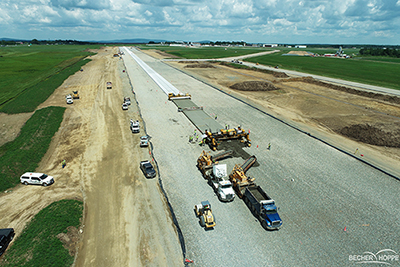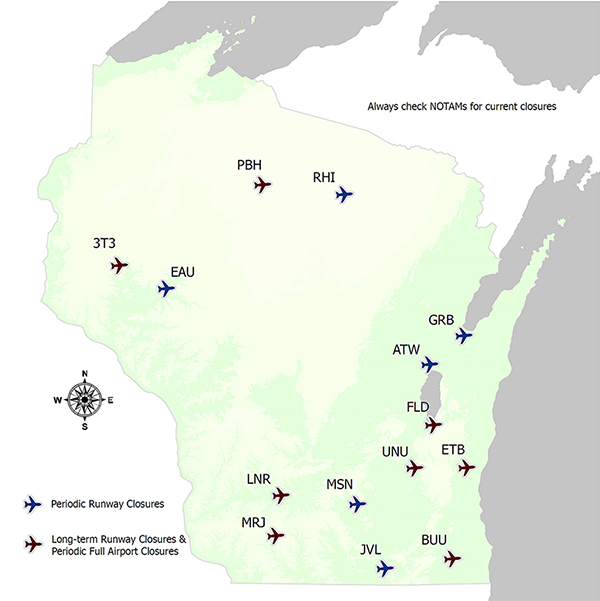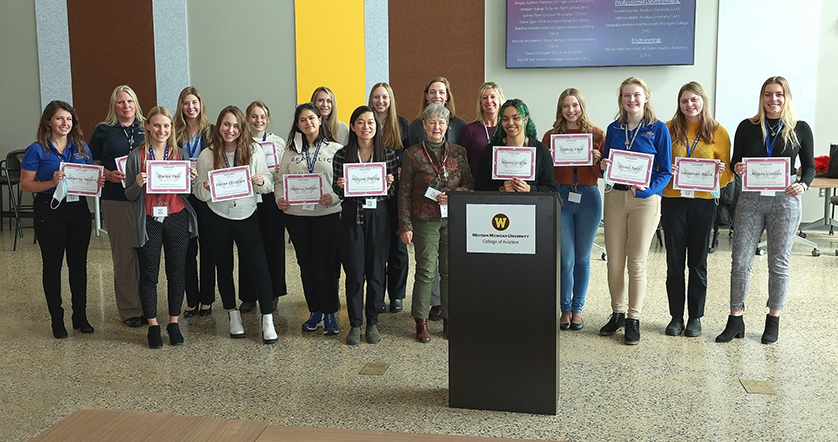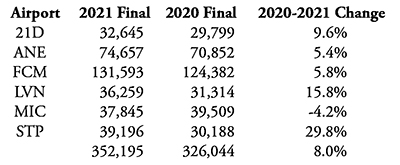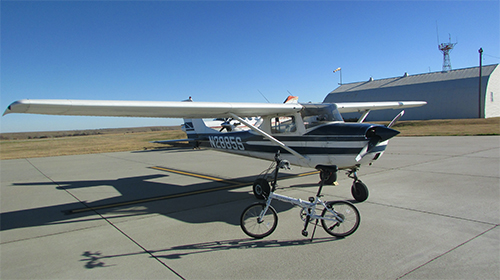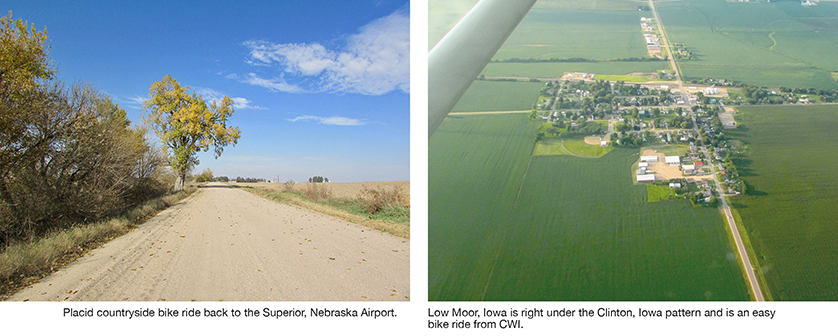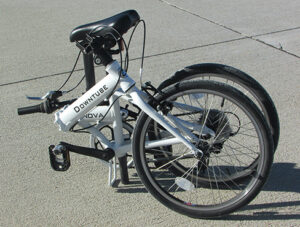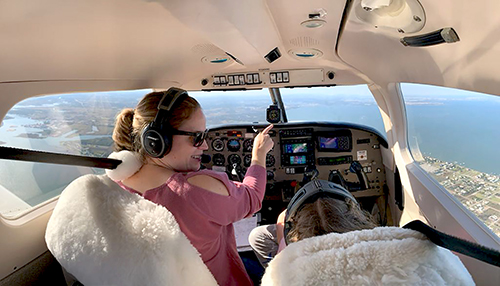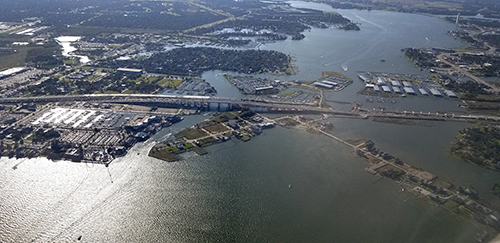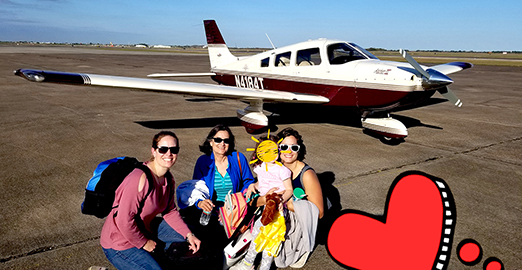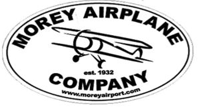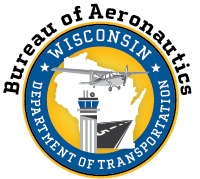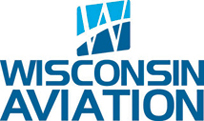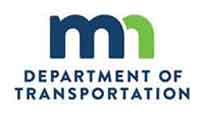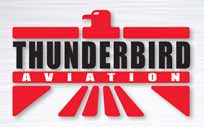by Dean Zakos
© Dean Zakos 2022. All Rights Reserved!
Published in Midwest Flyer Magazine April/May 2022 online issue
I am alone in a corner of the lounge at the FBO. From my window seat overlooking the runway, I can see that a beautiful Saturday morning is developing, with a forecast for widely scattered clouds and light winds from the southwest. It is going to be a great day for pancakes, eggs, and sausage. And some flying.
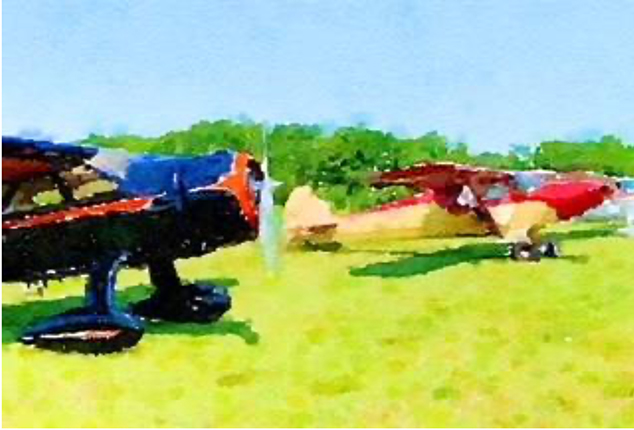
I am the first in our group to arrive at the airport. We had talked earlier in the week about meeting at 8:00 am at the FBO and flying to our chosen destination. The small airport hosting the pancake breakfast this morning is only about 45 minutes flying time away. In the warm weather months, you can find quite a few breakfasts to fly to on weekends. This one, held in mid-June every year is, by all accounts, one of the better ones. Good food and good company are a given but, beyond that, this one offers a turf runway and the opportunity to see many antique and classic aircraft. It is a popular breakfast and attracts aircraft from up to a hundred miles away.
Pilots and passengers begin showing up. I will be flying my airplane with a good friend in the right seat, who is also a pilot. I offer a backseat to any non-pilots looking for a ride. An older guy, white-haired and walking slowly, who I know by sight (I could not remember his name), asks if he could join us. I answer in the affirmative and we introduce ourselves (again) to each other. I think I have flown with this gentleman before. Although not an aviator, he loves airplanes, and is quite knowledgeable about World War II aircraft and airplane history.
After the group catches up on the airport’s happenings since last week and confirms it will be a CAVU (ceiling and visibility unlimited) day, we are ready to go. There will be six aircraft in our little squadron. Although we are all flying to the same destination, it will not be a formation, as all six aircraft are different – a V-tail Bonanza, a Piper Cherokee, two Cessna Skyhawks, my Grumman Tiger, and an RV-8A. I know from experience, with a variety of aircraft, our arrivals at the breakfast airport will be spaced out.
Soon the small crowd of pilots and passengers in the lounge is sorted out, and everyone has found a seat in an aircraft. The unwritten rule, for as long as I can remember, is that the pilot flying pays for the gas, and the pilot’s passengers pay for their own breakfasts, and that of the pilot. Always seemed fair to me, and this arrangement has worked well for us.
The Bonanza is the fastest airplane in the group and will likely land first. It is odd to me, but often the fastest airplane will also be the first off the ground. I never brought it up, but it would seem to make more sense to have the slowest airplane depart first, second slowest next, and so on, with the faster airplanes’ pilots and passengers loitering a few moments longer, so that our group all arrives at about the same time. That level of organization is, apparently, beyond the concern of most GA pilots out for a Saturday flight. I think pilots can be an impatient, and competitive, lot.
The owner of the Bonanza operates a small manufacturing business. He is a good pilot, conscientious, stays current, and takes some long IFR trips – to Florida, the west and east coasts, and to Canada.
The Cherokee is owned and flown by a pilot who works for the largest employer in town. He has advanced degrees, is smart as a whip, and is an engaging guy for conversation on just about any subject. It is an older Cherokee (with the handbrake and overhead trim crank), but the airplane is well-cared for. With the advent of GPS and ADS-B, this pilot has always chosen his own ingenuity over simply purchasing the latest pricey black boxes on the market and paying an avionics shop to install them in his panel. It is an interesting cockpit to see. I would describe it as a sort of a “Rube Goldberg meets NASA” décor,” with an iPad (or three) and several aftermarket avionics boxes duct-taped, velcroid, or zip-tied to the yokes, piled on top of the panel, or stuck on side windows, with power cords, wires, USB connections, and antennas running everywhere. Surprisingly, it all works, is compliant, and he is happy.
The Cessna Skyhawks are pretty much stock. One is owned by an individual, the other a partnership comprised of seven pilots. The partners represent a cross-section of the pilots on our airport. Ex-military, a cop, a firefighter, a teacher, an accountant, a factory worker, a nurse – all walks of life. That is one thing about general aviation that makes flying so interesting. The people you meet, from all backgrounds and locales, are all different, but hold a common and easily shared interest in aviation.
I have owned my Grumman Tiger for about 20 years. I started flying later in life. I thought I would have earned my Private Pilot Certificate earlier, but school, family, and work were my priorities, and those things necessarily made the largest demands on either my time or my money. I have a little more of both now, and eagerly look forward to our Saturday morning flyouts. What attracted me to the Tiger? – the sliding canopy, of course. I am never going to be able to sit in a fighter jet, so this is the closest I will ever be to my childhood dream – and I am okay with that.
The RV-8A is gorgeous. I never had any desire to build my own airplane, which is good, because I doubt I would want to fly in an airplane that I had a role in building. I am just not handy or talented enough. The owner/builder of the RV is. White, with bold blue stripes and a three-blade prop, the experimental airplane looks fast just sitting on the ramp. The pilot who built the RV-8A is obviously proud of his work, and it shows. He is sometimes reluctant to land on grass because of the nosewheel, but our destination airport has a reputation for being one of the finest turf runways in the area – long, wide, and smooth. He has room for one passenger in his tandem seating configuration and will probably be the second airplane into the air today.
Two of my good friends, a husband and wife, will not be able to join us this morning. I watched them build their VariEze, a Burt Rutan-designed homebuilt, sporting a pusher propeller, swept wings with winglets, and a canard, over several years in the T-hangar next to mine. It required long hours and they encountered many challenges, but they are pleased with the result of their efforts. I remember when they were sanding the composite exterior. They would often emerge from their hangar after a few hours looking like they had been engaged in a competition, the object of which appeared to be who could pelt the other with the most 5 lb. pound sacks of flour. They loved the project, and they love flying.
Sun showers the cockpit in morning light on climb-out. I glance over my right shoulder at the passenger sitting behind me. Unconsciously, his mouth is open slightly and his eyes wide; he is unaware of his facial expressions. Instead, he is completely absorbed by the sharp-edged cumulus clouds floating in a boundless blue sky passing off our wingtips as we ascend to our cruise altitude.
I think, as pilots, we sometimes take for granted what a gift flying is. I have been flying long enough that I am afraid some of the wonder is gone for me. It should not be, but it takes seeing someone else’s natural reaction to remind me, once again, that sitting at the controls of an airplane, climbing through the air, and taking in the extraordinary views out of a cockpit window are, indeed, magical.
We are level now at 2,500 feet and chatting amiably. Roads, farms, lakes, towns, all roll by beneath us at a steady pace. The morning air is smooth as glass. Visibility is unlimited. What a day! I have friends who are airline or corporate pilots, and they sometimes ask to fly with me on weekends. They want to fly low and slow. Jets and turboprops are fine for the flight levels, but the unhurried pace generated by a four-cylinder Lycoming or Continental, the ability to see clearly what you are looking at on the ground, is part of every pilot’s roots, and what every pilot yearns to return to.
About 15 miles out from our destination, I tune to the nearest ASOS broadcast, the grass strip having no weather reporting capability. The synthesized voice informs us the winds are from 260 degrees at 5 knots. Few clouds at 2,300 feet. I next tune in the CTAF frequency where we will land, anticipating that this morning, even though it is only a turf runway nestled among rolling farm fields, there may be a lot of traffic on the frequency. There is. Everybody and their little sister like pancakes. Based on position reports we are hearing, there are three aircraft in the pattern, and six more within 5 miles, all approaching from different directions. Traffic is landing to the west. We are approaching from the east. We will continue to monitor the traffic situation the rest of the way and keep our heads on a swivel. Ten miles out, I make our first reporting call, and turn my strobes and landing light on. We will land on Runway 27, with the traffic flow.
Five miles out, based on who is currently in the pattern or approaching at our estimated time of arrival, I advise traffic that we will overfly the field above the pattern and turn midfield left crosswind for 27. There is a Champ on base about to turn final, a Skyhawk 5 miles north that will enter a left crosswind for 27, presumably behind us, and a Stinson inbound from the west. We are not yet sure of the Stinson’s position or intentions. My pilot friend reminds me that, although we think we have a good mental picture of the traffic and an active ADS-B screen, there still may be aircraft without radios or ADS-B Out, entering the pattern. This is no time to be complacent, thinking only of how good the scrambled eggs will be.
Turning base to final for Runway 27, I remain vigilant for any aircraft that may be attempting to sneak in around or under us. Hearing and seeing none, we proceed to land. If everyone follows the rules, exercises some common sense, and remains cautious, we should all continue to be safe. The turf is smooth, closely cut, and inviting. A volunteer in a Day-Glo vest holding two orange wands over his head catches my attention near the end of our rollout and directs us to parking.
As we taxi, I slide the canopy back so we can enjoy the smell of freshly mown grass and the unmistakable aroma of breakfast sausage. We are marshalled to the next open spot in a long row of colorful aircraft facing the runway. I notice several familiar airplanes and tail numbers.
The breakfast is prepared and served in a large hangar. Volunteers have moved aircraft out, swept it clean, and set up long, neat rows of tables and chairs. An American flag hangs on one wall. As we stand in line, I notice the tables are adorned with plastic tablecloths and bottles of maple syrup, and each displays a simple vase with a few freshly cut flowers. It is a nice touch. Men and women in yellow T-shirts sit at a table in front of a cash box, ready to take our money and engage in friendly conversation. “Where did you fly in from?” and “How was your flight?” are two of the more popular and often-asked questions. “Thank you for stopping in today,” almost always accompanies being pointed in the direction of the next station, toward the napkins, plates, and silverware.
More yellow T-shirts expertly pour batter and flip pancakes on round, rotating griddles, scramble dozens of fresh eggs, or constantly replenish aluminum pans of piping hot pork sausages. Some volunteers move from table to table, bringing new supplies of syrup, cleaning up spills and errant clutter, or simply chatting with the diners. A good breakfast only works well because of the myriad of volunteers involved. Nothing happens without them. Small airports would be less interesting and a lot less cheery without volunteers, who seem to be always smiling and willing to lend a hand.
Pancake breakfasts are a proud tradition. At the next table over, there is a family with three generations of pilots. The grandfather learned to fly in the 1950s; the son learned to fly in the 1970s; and the granddaughter flies today as a 737 Captain for Southwest Airlines. The local community has come out to support the breakfast as well. Families wait in line patiently, some with small children holding toy airplanes in their hands, gesturing excitedly, and asking questions about the aircraft around them. Outside the hangar, there is a small group of Explorer Scouts, probably from a local Post, who often provide their volunteer services to events like this.
There are few things in life better than flying into a pancake breakfast and recognizing old friends sitting around you who also flew in for the morning. Friendship in aviation is easily found. Once friends are made, they stay made for years, regardless of the passing of time or the miles between them. I watch as one group of pilots approaches another, smiles of recognition on their faces, and extend greetings with handshakes and inquiries about the morning’s flight, the local aviation news, or the latest paint jobs or interior renovations on their planes.
We dawdle over remnants of our breakfasts and by now, cool coffee, talking of flying and airplanes, and taking in the noisy, bustling atmosphere inside the hangar. Being mindful of the line of people still waiting to eat, we give up our table, buss our trash to the nearest receptacle, and walk back outside into the warm sunlight.
The lines of parked aircraft have grown larger since we landed, and there are still airplanes arriving. Rather than heading back right away, we choose to walk off a few calories and our interest takes us first to the flight-line and the rows of aircraft on display there. Antiques, classics, and more modern airplanes are comingled on all available flat surfaces. There is even a few warbirds in attendance, as I notice a bare aluminum North American T-6 Texan, and a Boeing Stearman painted in Army Air Corps trainer colors parked not far from each other. Over there is a black-over-red Beech Staggerwing parked next to a Robin’s egg blue gull-wing Fairchild, both looking as good as the days they rolled off their assembly lines.
There are a few vendors here too, taking advantage of the crowd drawn to the airport this morning. Local organizations, such as the EAA Chapter and Women in Aviation International, offer literature, promote scholarships, and hand out application forms. They are happy to answer questions about memberships and activities. You can purchase aviation-themed T-shirts or coffee mugs spread out on a table if you are so inclined. There is a frail, gray-haired gentleman I recognize sitting at a card table, copies of the book he authored piled high in front of him. He is waiting to chat about his life in the air and, if you buy a book, he will gladly sign it for you. Like so many of us, he was never an astronaut, military pilot, or airline captain, but he still has interesting flying stories to tell.
We next walk down a row of wood framed, rust-tinged, corrugated metal hangars, many of which have stood on this airport since before I was born, their weathered doors open, inviting us in. A Pietenpol sits in the first hangar, the owner talking in animated fashion to an admirer. The next hangar houses a Cessna 140. Two doors down, a brightly painted Taylorcraft catches our attention. A Piper Tri-Pacer, looking neglected, tires flat, prop missing, half covered in a ragged tarp, half covered in dust and cobwebs, sits forlornly in another hangar. Often, someone in our group can add some detail or a comment about an airplane we are inspecting:
“I soloed in a Cessna 140 in 1974.”
“My dad took me for my first airplane ride when I was 5 years old in the Skyhawk he owned and flew off the grass strip on our farm.”
“I have always wanted to fly a Tri-Pacer. I wonder if it might be for sale!”
The morning passes enjoyably, and quickly. It is time to depart. I smile to myself, thinking about our flight and just concluded breakfast. Men and women we never knew, now gone west, who were so very much like us, landed on this same grass strip, enjoyed breakfasts with their friends and families, and strolled these same grounds. I do not often think about participating in what has become a flying tradition extending to pilots and airports across the Midwest, but when I do, I am pleased to be a part of it.
Over time, each of us, contributing his or her own story, adds to and becomes part of aviation’s heritage. That heritage, in turn, belongs to all of us. Pilots who come after us, I am certain, will feel the same way.
Climbing above the horizon into a bright sky, I key the microphone and transmit our intention to depart the pattern and head east, setting course for home. I am already looking forward to next Saturday.
EDITOR’S NOTE: Dean Zakos (Private Pilot ASEL, Instrument) of Madison, Wisconsin, is the author of “Laughing with the Wind, Practical Advice and Personal Stories from a General Aviation Pilot.” He has also written numerous short stories and flying articles for Midwest Flyer Magazine and other aviation publications.
DISCLAIMER: The information contained in this column is the expressed opinion of the author only and should not be used for flight planning purposes.
 The MN Content Packs can also be downloaded on a computer and sent as an attachment to yourself or others – just open mail on your iPad, tap, and hold the email attachment. Once the “share” option appears, scroll to find ForeFlight and select “copy to ForeFlight.” This will bring the Content Pack into the More > Custom Content part of ForeFlight. From the Custom Content, users can open the MN Airport Directory Content Pack within ForeFlight and view all of the content. Two of the best ways to use the Content Packs are by searching for a MN airport, or finding one via the map. Once on the airports page, go to procedure, and you’ll see MN Airport Directory. If it isn’t highlighted, tap the MN Airport Directory, and the directory page will be available to tap (right-hand side). Clicking on the directory page will open a new “Plates” page and display the directory, just like an approach chart. Swipe to display the second page.
The MN Content Packs can also be downloaded on a computer and sent as an attachment to yourself or others – just open mail on your iPad, tap, and hold the email attachment. Once the “share” option appears, scroll to find ForeFlight and select “copy to ForeFlight.” This will bring the Content Pack into the More > Custom Content part of ForeFlight. From the Custom Content, users can open the MN Airport Directory Content Pack within ForeFlight and view all of the content. Two of the best ways to use the Content Packs are by searching for a MN airport, or finding one via the map. Once on the airports page, go to procedure, and you’ll see MN Airport Directory. If it isn’t highlighted, tap the MN Airport Directory, and the directory page will be available to tap (right-hand side). Clicking on the directory page will open a new “Plates” page and display the directory, just like an approach chart. Swipe to display the second page.







